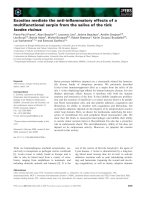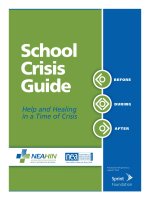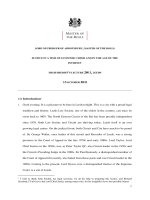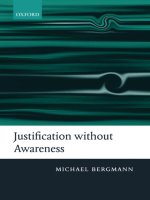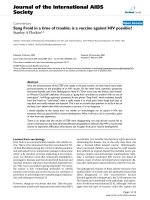- Trang chủ >>
- Khoa Học Tự Nhiên >>
- Vật lý
not a suicide pact the constitution in a time of national emergency sep 2006
Bạn đang xem bản rút gọn của tài liệu. Xem và tải ngay bản đầy đủ của tài liệu tại đây (1.53 MB, 186 trang )
Not a Suicide Pact:
The Constitution in a
Time of National Emergency
Richard A. Posner
OXFORD UNIVERSITY PRESS
not a suicide pact
. . .
series editor
Geoffrey R. Stone
r i g h t s s e r i e si n a l i e n a b l e
Lee C. Bollinger
President
Columbia University
Alan M. Dershowitz
Felix Frankfurter Professor of Law
Harvard Law School
Richard A. Epstein
James Parker Hall
Distinguished Service Professor
University of Chicago Law School
Pamela S. Karlan
Kenneth and Harle Montgomery
Professor of Public Interest Law
Stanford Law School
Alexander Keyssar
Matthew W. Stirling, Jr. Professor of
History and Social Policy
JFK School of Government,
Harvard University
Michael J. Klarman
James Monroe Distinguished
Professor of Law and History
University of Virginia
Larry D. Kramer
Richard E. Lang Professor of
Law and Dean
Stanford Law School
Lawrence Lessig
C. Wendell and Edith M. Carlsmith
Professor of Law
Stanford Law School
Michael W. McConnell
Judge
U.S. Court of Appeals for
the Tenth Circuit
Martha C. Nussbaum
Ernst Freund Distinguished Service
Professor, Philosophy, Law, Divinity,
South Asian Studies
The University of Chicago
Richard A. Posner
Judge
U.S. Court of Appeals for
the Seventh Circuit
Jack N. Rakove
William Robertson Coe Professor of
History and American Studies
Stanford University
Geoffrey R. Stone
Harry Kalven, Jr. Distinguished
Service Professor
University of Chicago Law School
Kathleen M. Sullivan
Stanley Morrison Professor of
Law and Former Dean
Stanford Law School
Laurence H. Tribe
Carl M. Loeb University
Professor of Law
Harvard Law School
Mark Tushnet
William Nelson Cromwell
Professor of Law
Harvard Law School
Not a Suicide Pact
. . .
the constitution in a
time of national emergency
Richard A. Posner
2006
Oxford University Press, Inc., publishes works that further
Oxford University’s objective of excellence
in research, scholarship, and education.
Oxford New York
Auckland Cape Town Dar es Salaam Hong Kong Karachi
Kuala Lumpur Madrid Melbourne Mexico City Nairobi
New Delhi Shanghai Taipei Toronto
With offices in
Argentina Austria Brazil Chile Czech Republic France Greece
Guatemala Hungary Italy Japan Poland Portugal Singapore
South Korea Switzerland Thailand Turkey Ukraine Vietnam
Copyright © 2006 by Oxford University Press
Published by Oxford University Press, Inc.
198 Madison Avenue, New York, New York 10016
www.oup.com
Oxford is a registered trademark of Oxford University Press
All rights reserved. No part of this publication may be reproduced,
stored in a retrieval system, or transmitted, in any form or by any means,
electronic, mechanical, photocopying, recording, or otherwise,
without the prior permission of Oxford University Press.
Library of Congress Cataloging-in-Publication Data
Posner, Richard A.
Not a suicide pact : the constitution in a time
of national emergency / by Richard A. Posner.
p. cm. Includes index.
ISBN-13: 978-0-19-530427-5 (cloth)
ISBN-10: 0-19-530427-6 (cloth)
1. Civil rights—United States.
2. National security—Law and legislation—United States.
I. Title.
KF4749.P67 2006 342.7308'5—dc22
2006005345
1 3 5 7 9 8 6 4 2
Printed in the United States of America
on acid-free paper
The choice is not between order and liberty. It is between liberty
with order and anarchy without either. There is danger that, if the
Court does not temper its doctrinaire logic with a little practical
wisdom, it will convert the constitutional Bill of Rights into a sui-
cide pact.
—Justice Robert Jackson,
dissenting in
Terminiello v. City of Chicago
(1949)
. . .
While the Constitution protects against invasions of individual rights,
it is not a suicide pact.
—Justice Arthur Goldberg,
for the Court, in
Kennedy v. Mendoza-Martinez
(1963)
. . .
As Justice Jackson put it in a now often-quoted remark, we cannot
allow our Constitution and our shared sense of decency to become a
suicide pact.
—Professor Ronald Dworkin,
in the
New York Review of Books
(2002)
This page intentionally left blank
Editors’ Note
ix
Introduction
1
chapter one
How Are Constitutional Rights Created?
17
chapter two
How Does National Security Shape Constitutional Rights?
31
chapter three
Rights Against Detention
53
. . .
Contents
chapter four
Rights Against Brutal Interrogation,
and Against Searches and Seizures
77
chapter five
The Right of Free Speech,
with a Comment on Profiling
105
chapter six
Rights of Privacy
127
Conclusion
147
Further Readings
159
Index
165
contents
. . .
Editors’ Note
We hold these truths to be self-evident, that all men are created
equal, that they are endowed by their Creator with certain unalien-
able Rights. . . .
—The Declaration of Independence
This volume is the first in a new series on Inalienable Rights. Each
book illuminates why a right or set of rights is in the Constitution (or
has remained outside it), and then explores the controversies the
right has provoked. Rights invite discussion: What is a constitutional
right? What are the counterbalancing duties? Rights are often inde-
terminate and under pressure from a variety of sources. Authors in
this series have their own points of view, and in these volumes they
will declare and defend them. Civic debate is at the heart of the
American political process. The Inalienable Rights series is designed
to challenge readers to question their own assumptions about these
foundational canons of our society.
Richard Posner’s Not a Suicide Pact: The Constitution in a Time of Na-
tional Emergency addresses a key dilemma as we struggle to maintain
editors’ note
[ x ]
our equilibrium in an era of intense security concerns and growing
threats to long-held liberties. When terrorists can kill tens of thou-
sands by spraying aerosolized anthrax or detonating dirty bombs, how
should we properly balance our interest in personal liberty with our
interest in public safety? What are the roles of the executive, the
Congress, and the judiciary when a crisis is at hand? To what extent
should civil liberties vary with threat levels?
Richard Posner here dissects the constitutional issues raised by
such controversial policies as detention, torture, data mining, and
the interception of phone calls and other electronic communications.
He argues that rights should be modified according to circumstance
and that we must find a pragmatic balance between personal liberty
and community safety. Such balancing cannot easily be translated
into fixed rules, or even legislation. Sometimes, as with Lincoln’s
decision to suspend habeas corpus during the Civil War, the immedi-
ate situation must take precedence over rules. Posner contends that
if we do not allow the Constitution to bend, it may break.
This is a controversial claim, and it is therefore in the spirit of
this series. In a vibrant democracy, controversial viewpoints stimu-
late critical engagement. The framers of the Constitution could not
have envisioned the cell phone, the wiretap, or the dirty bomb, but
they were not naïve about societal and technological change. They
hoped that the democratic processes they had created would enable
enlightened citizens and their representatives to amend or adapt
traditional policies as necessary after suitable debate.
The Bill of Rights itself was controversial and almost died in Con-
gress. James Madison championed the idea of enumerating specific
freedoms in the new Constitution by arguing that only by securing
“the great rights of mankind” could abuse of power be prevented.
Madison maintained that the courts, the “independent tribunals of
justice,” would make themselves “the guardian of those rights” and
serve as “an impenetrable bulwark” against improper “assumption of
editors’ note
[ xi ]
power in the legislative or executive.” Which leads us back to Rich-
ard Posner’s thesis. Are the courts the primary guardians of our rights,
or must they defer to the executive “in time of national emergency”?
Who is best positioned to make the pragmatic judgments on which
our safety and liberties depend? Let the debate begin.
April 2006 Geoffrey R. Stone
Dedi Felman
This page intentionally left blank
not a suicide pact
This page intentionally left blank
. . .
Introduction
THIS IS A BOOK ABOUT THE CONSTITUTIONAL RIGHTS that impinge on the
measures for the protection of national security that the U.S. gov-
ernment has taken in response to the terrorist attacks of September
11, 2001. It is thus about the marginal adjustments in such rights
that practical-minded judges make when the values that underlie
the rights—values such as personal liberty and privacy—come into
conflict with values of equal importance, such as public safety, sud-
denly magnified by the onset of a national emergency. Like any brittle
thing, a Constitution that will not bend will break.
The history of the United States has been punctuated by these
emergencies. The greatest, after the early years of the Republic, was
the Civil War; the crisis of constitutionalism that emergencies beget
remains a legacy of that desperate struggle. The number of national
emergencies accelerated in the twentieth century as the United
States became a world power and then a nuclear power confronting
other nuclear powers. There were the two world wars; the nation’s
greatest economic depression, coinciding with the rise of totalitari-
anism abroad in the 1930s; the Cold War, which lasted from 1948 to
not a suicide pact
[ 2 ]
1989 and was punctuated by episodes of espionage, war, and near war
(for example, the Cuban missile crisis); and, embedded within the
Cold War, the Vietnam War and the domestic unrest and governmen-
tal overreactions that the war sparked in the late 1960s and early 1970s.
All these episodes placed pressure on existing constitutional un-
derstandings. Now, in the early years of the twenty-first century, the
nation faces the intertwined menaces of global terrorism and prolif-
eration of weapons of mass destruction. A city can be destroyed by
an atomic bomb the size of a melon, which if coated with lead would
be undetectable. Large stretches of a city can be rendered uninhab-
itable, perhaps for decades, merely by the explosion of a conven-
tional bomb that has been coated with radioactive material. Smallpox
virus bioengineered to make it even more toxic and vaccines ineffec-
tual, then aerosolized and sprayed in a major airport, might kill mil-
lions of people. Our terrorist enemies have the will to do such things
and abundant opportunities, because our borders are porous both to
enemies and to containers. They will soon have the means as well.
The march of technology has increased the variety and lethality of
weapons of mass destruction, especially the biological, and also, criti-
cally, their accessibility. Aided by the disintegration of the Soviet
Union and the acquisition of nuclear weapons by unstable nations
(Pakistan and North Korea, soon to be joined, in all likelihood, by
Iran), technological progress is making weapons of mass destruction
ever more accessible both to terrorist groups (and even individuals)
and to hostile nations that are not major powers. The problem of
proliferation is more serious today than it was in what now seem the
almost halcyon days of the Cold War; it will be even more serious
tomorrow.
I am not a Chicken Little, and I agree with those who argue that
our vigorous campaign against al-Qaeda and our extensive if chaotic
efforts at improving homeland security have bought us a breathing
space against terrorist attacks on U.S. territory. But how long will
introduction
[ 3 ]
this breathing space last? The terrorists, their leadership decimated
and dispersed, may be reeling, but they have not been defeated. In
January 2006 Osama bin Laden declared that there would be further
terrorist attacks on the United States; it would be reckless to dis-
miss his declaration as idle boasting. This is not the time to let down
our guard.
David Luban asks: “What sacrifice in our rights would we be will-
ing to undergo to reduce the already-small probability of another
September 11 by a factor of, say, one in ten? From, let us say, one
percent annually to point-nine percent—an annual saving of less than
half a statistical life?” Those are not good questions. We have no idea
whether the probability of another 9/11 (or worse) is only 1 percent.
The research that I have been conducting for the past several years
on catastrophic risks, international terrorism, and national security in-
telligence has persuaded me that we live in a time of grave and in-
creasing danger, comparable to what the nation faced at the outset of
World War II. The insights from that research, combined with my long-
standing interest and (as a judge) activity in constitutional law, have
moved me, and I hope equipped me, to write this book.
Not all national emergencies are consequences of war or terror-
ism. I mentioned the Great Depression. Natural disasters, too, can
create emergency conditions that invite legally and even constitu-
tionally problematic responses. Imagine strict quarantining and com-
pulsory vaccination in response to a pandemic, or the imposition of
martial law in response to a catastrophic earthquake, volcanic erup-
tion, tsunami, or asteroid strike. When New Orleans was inundated
as a result of Hurricane Katrina in the late summer of 2005, propos-
als to use soldiers to help maintain law and order met objections
based on long-standing fears of military intervention in domestic cri-
ses, fears that had been codified in an 1878 law called the Posse
Comitatus Act. The act had signaled the end of the post–Civil War
Reconstruction era by making it a crime to use the federal armed
not a suicide pact
[ 4 ]
forces (as distinct from the state militias—the National Guard) for
law enforcement unless an act of Congress expressly authorizes such
use. Invocation of the Posse Comitatus Act was actually just an ex-
cuse for inaction in the New Orleans emergency because an act of
Congress (the Stafford Act) does authorize the use of the armed forces
to assist in emergencies. More fundamentally, in conditions of great
danger legalistic limitations fall by the wayside; officials act, leaving
the legal consequences to be sorted out later.
Indeed, if interpreted to prevent the president from responding
effectively to a major emergency, the Posse Comitatus Act might be
deemed an unconstitutional limitation on sovereign power and ex-
ecutive prerogative. In United States v. Curtiss-Wright Export Corp.
(1936), the Supreme Court held that the United States acquired
the powers of a sovereign nation by its successful revolution against
Great Britain rather than by a grant in the Constitution; the nation
is prior to the Constitution. National defense, not limited to de-
fense against human enemies, is a core sovereign power and more-
over one that traditionally is exercised by the executive. The
particular context of Curtiss-Wright was the nation’s foreign relations.
But the principle of the case—that national power is not limited to
the powers explicitly granted by the Constitution—is broader, and
anyway our main terrorist enemies are foreign nonstate groups that
pose a threat to the nation greater than that of most foreign states.
The Katrina-begotten controversy over the Posse Comitatus Act
illustrates how emergencies can squeeze civil liberties. The na-
tional security measures adopted after the 9/11 attacks provide many
other illustrations of the squeeze; I have sought to anchor my analy-
sis in them.
The core meaning of “civil liberties” is freedom from coercive or
otherwise intrusive governmental actions designed to secure the
nation against real or, sometimes, imagined internal and external
enemies. The concern is that such actions may get out of hand, cre-
introduction
[ 5 ]
ating a climate of fear, oppressing the innocent, stifling indepen-
dent thought, and endangering democracy. Civil liberties can even
be thought of as weapons of national security, since the government,
with its enormous force, is, just like a foreign state, a potential en-
emy of the people. Civil liberties are also means of bringing the judi-
ciary into the national security conversation, with a perspective that
challenges that of the national security experts. The separation of
powers has epistemic as well as political significance: competition
among branches of government can stimulate thought, correct er-
rors, force experts to explain themselves, expose malfeasance, and
combat slack and complacency.
But the more numerous or dangerous the nation’s enemies are
believed to be, the greater the pressure to curtail civil liberties in
favor of executive discretion and unity of command, in order to en-
able the government to wield its great power more effectively, if less
responsibly. The traditional internal enemies are criminals, though
in the Civil War they were rebels. The traditional external enemies
are foreign states. But at present, with U.S. crime rates well below
their historic highs and no major power posing a significant military
threat to the nation, the external enemies whom Americans mainly
fear are Islamist terrorists. And with good reason: they are numer-
ous, fanatical, implacable, elusive, resourceful, resilient, utterly ruth-
less, seemingly fearless, apocalyptic in their aims, and eager to get
their hands on weapons of mass destruction and use them against us.
They did us terrible harm on September 11, 2001, and may do us
worse harm in the future. We know little about their current num-
ber, leaders, locations, resources, supporters, motivations, and plans;
and in part because of our ignorance, we have no strategy for defeat-
ing them, only for fighting them. Although our invasion of Afghani-
stan shortly after the 9/11 attacks and our subsequent vigorous
counterterrorist efforts have scattered the leadership of al-Qaeda, as
well as depriving the movement of its geographic base (though it has
not a suicide pact
[ 6 ]
obtained a quasi-sanctuary in Pakistan), we are far from victory. In-
deed, it is arguable that we have lost ground since 9/11—that the
spectacular success of the 9/11 attacks did more to turn the Muslim
world against the West than the vigorous military and police response
to Islamist terrorism has done to weaken the terrorist movement.
Yet all this is speculation. For all we know, we may be quite safe. But
we cannot afford to act on that optimistic assumption.
I call the Islamist terrorists external enemies because very few of
them, it appears, are American citizens or even residents of the United
States (though the few who are may be especially dangerous). They
are neither rebels nor common criminals. But they differ from our
previous external enemies, such as the Axis powers in World War II
and the Soviet Union during the Cold War, and even for that matter
the Confederacy in the Civil War, because those enemies opposed us
with organized military forces. They operated through subversion as
well as military confrontation—quite serious subversion during the
Civil War and the early years of the Cold War (and before—in fact,
Soviet penetration of the U.S. government peaked during World War
II). But the primary threats were military. A military enemy can usu-
ally be fought with minimal impairment of civil liberties beyond con-
scription and the censorship of militarily sensitive information. But
terrorists do not field military forces that we can grapple with in the
open. And they are not content to operate against us abroad; they
penetrate our country by stealth to kill us. Rooting out an invisible
enemy in our midst might be fatally inhibited if we felt constrained
to strict observance of civil liberties designed in and for eras in which
the only serious internal threat (apart from spies) came from com-
mon criminals.
But just as attacks by terrorists or foreign nations are not the only
source of national emergencies, so not all forms of terrorism create
national emergencies warranting the curtailment of existing rights.
The tendency to equate any politically motivated violent crime with
introduction
[ 7 ]
terrorism should be resisted. Many such crimes, such as those com-
mitted by animal-rights fanatics, are no more dangerous than run-of-
the-mill crimes. My concern is limited to terrorism that has the
potential to create a national emergency. This qualification should
be borne in mind throughout the book.
Subversive activities during the Civil War and the Cold War be-
got severe responsive measures, such as suspension of habeas corpus
in the earlier struggle and the prosecution of communist leaders in
the later one. In the wake of 9/11 the federal government adopted
measures that at first encountered little resistance from the public
or politicians but since have become controversial as the attacks re-
cede in time and the anxiety caused by them concomitantly dimin-
ishes. The measures and the initial acquiescence in them by the
public were the predictable responses to a sudden sharp increase in
a perceived threat to the nation’s safety. The central question ad-
dressed in this book is how far civil liberties based on the Constitu-
tion should be permitted to vary with the threat level.
The qualification “based on the Constitution” requires empha-
sis. Many protections of civil liberties are of purely statutory origin.
The Posse Comitatus Act is one example. The right of convicted
criminals to obtain judicial review by means of habeas corpus is an-
other; the Constitution limits suspension of habeas corpus, but the
right of habeas corpus thus presupposed is, as we’ll see in Chapter 3,
more limited than the statutory right. A third example is the statu-
tory right of a college student to insist that his grades not be dis-
closed to a prospective employer. Some civil liberties protections
originate in treaties, such as the Convention Against Torture, to which
the United States is a party. It is a mistake to think that “constitu-
tional” is a compliment. Much that the government is permitted by
the Constitution to do it should not do and can be forbidden to do by
legislation or treaties. Constitutional law is intended to be a loose
garment; if it binds too tightly, it will not be adaptable to changing
not a suicide pact
[ 8 ]
circumstances and will leave too little room for the play of democratic
forces. The analysis in this book is limited to constitutional law, so
from now on, unless otherwise indicated, when I use the term “civil
liberties” I mean “civil liberties derived from the Constitution.”
A related point is the distinction between right and power. One
way to oppose an exertion of legislative or executive power is to ar-
gue that it violates rights. But another is to argue that it simply ex-
ceeds the lawful power of the legislature or the executive. A local
business firm that Congress attempts to regulate can object that
Article I of the Constitution, which authorizes Congress to regulate
interstate and foreign commerce, doesn’t authorize it to regulate a
purely local business. But it would be a stretch to argue that the
regulation invaded a constitutional right. Unauthorized action is not
necessarily the infringement of a right. My subject is constitutional
rights, so I shall not be concerned with limitations on government
power that do not protect such rights. But I will be very concerned
with constitutionally conferred powers of government that limit those
rights. The scope of governmental power to take actions to protect
national security is the reciprocal of the individual’s rights to liberty
and privacy. So this is a book about the Constitution, not just about
constitutional rights.
Although the title of this book evokes a history of emergency
measures that goes back to the founding of the nation, this is not a
work of history. Thus I am not much interested in what rights rebels
and their sympathizers might have in a civil war. The threat of an-
other civil war is not what is placing pressure on constitutional rights
today. The pressure is coming mainly, though not entirely, from the
threat of terrorism in a world increasingly menaced by weapons of
mass destruction. (I shall generally term this the threat of “modern
terrorism.”) The question is how far this pressure should be resisted.
Chapter 1 discusses how constitutional rights are created and ar-
gues that the principal creators are not the actual draftsmen or ratifiers
introduction
[ 9 ]
of the constitutional text but the justices of the Supreme Court, and
that the justices are heavily influenced by the perceived practical
consequences of their decisions rather than being straitjacketed by
legal logic. As a result, constitutional law is fluid, protean, and re-
sponsive to the flux and pressure of contemporary events. The elas-
ticity of constitutional law has decisive implications for the scope of
constitutional rights during an emergency.
Chapter 2 applies the approach sketched in Chapter 1 to civil
liberties, arguing that they are the point of balance between con-
cerns for personal liberty and concerns for public safety. The former
concerns are the basis of constitutional rights; the latter are the ba-
sis of government powers, which limit some rights (while, of course,
creating many others, but statutory rights are not my subject) but
which are as firmly grounded in constitutional values as constitu-
tional rights are. It would be odd if the framers of the Constitution
had cared more about every provision of the Bill of Rights than about
national and personal survival. In times of danger, the weight of con-
cerns for public safety increases relative to that of liberty concerns,
and civil liberties are narrowed. In safer times, the balance shifts the
other way and civil liberties are broadened. Civil libertarians disagree
with this method of determining the scope of civil liberties; I ex-
plain in Chapter 2 why I think their approach flawed and their fears
of a more flexible, practical approach unfounded.
Most civil libertarians look almost exclusively to the courts, and
to constitutional law fashioned and enforced by courts, to safeguard
civil liberties in periods of national emergency as at other times. Their
court-centric approach is shortsighted. Judges, knowing little about
the needs of national security, are unlikely to oppose their own judg-
ment to that of the executive branch, which is responsible for the
defense of the nation. They are especially unlikely to interpose con-
stitutional objections because of the difficulty of amending the Con-
stitution to correct judicial error. Conservative judges are particularly
not a suicide pact
[ 10 ]
unlikely to resist claims of national security—and the federal judi-
ciary may be more conservative today than at any other time in the
last half century.
Fortunately, when national security measures are agreed on by
Congress and the president, the need for judicial intervention di-
minishes. The legislative and executive branches are rivalrous even
when nominally controlled by the same political party; the Republi-
can Congress has not been a rubber stamp for the national security
initiatives of the Bush administration. To an extent not acknowl-
edged by civil libertarians, the Court can sit back and let the other
branches duke it out, for when the competitive branches agree on a
measure, the likelihood of its being an exaggerated response to a
perceived danger is diminished.
The four succeeding chapters, Chapters 3 through 6, analyze the
three principal sets of constitutional rights that come under pres-
sure in times of real or imagined national emergency. I concentrate
on the post-9/11 counterterrorist measures, actual and contemplated,
that have engendered the most controversy. They include the attempt
to deny the right of habeas corpus to captured terrorist suspects; the
interception of phone calls and other electronic communications, such
as e-mails, of U.S. citizens by the National Security Agency outside
the limits set by the Foreign Intelligence Surveillance Act; ambi-
tious data-mining projects such as the military’s Able Danger project;
demands by the FBI under section 215 of the USA PATRIOT Act for
records of library borrowings; monitoring of the constitutionally pro-
tected speech of radical imams; torture or quasi-torture of terrorist
suspects; and establishment of military tribunals to try suspected
terrorists, including U.S. citizens apprehended in the United States
rather than on a foreign field of combat such as Afghanistan or Iraq.
The general argument of these chapters is that the scope of con-
stitutional liberties is rightly less extensive at a time of serious ter-
